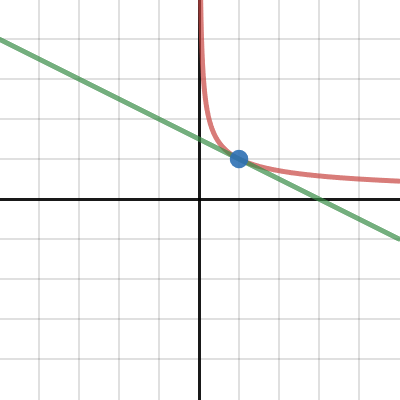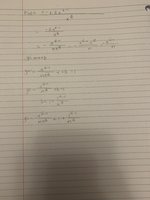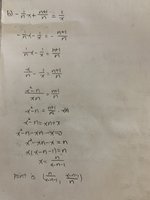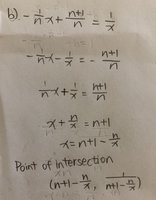You are using an out of date browser. It may not display this or other websites correctly.
You should upgrade or use an alternative browser.
You should upgrade or use an alternative browser.
Tangent line questions!
- Thread starter farealol
- Start date
- Joined
- Nov 24, 2012
- Messages
- 3,021
(a) I would write:
[MATH]f(x)=x^{-\frac{1}{n}}[/MATH]
Thus:
[MATH]f'(x)=-\frac{1}{n}x^{-\frac{1}{n}-1}=-\frac{1}{n}x^{-\frac{n+1}{n}}[/MATH]
And so the tangent line will be:
[MATH]y=f'(1)(x-1)+1=-\frac{1}{n}(x-1)+1=-\frac{1}{n}x+\frac{n+1}{n}[/MATH]
Here's a live graph:

 www.desmos.com
www.desmos.com
[MATH]f(x)=x^{-\frac{1}{n}}[/MATH]
Thus:
[MATH]f'(x)=-\frac{1}{n}x^{-\frac{1}{n}-1}=-\frac{1}{n}x^{-\frac{n+1}{n}}[/MATH]
And so the tangent line will be:
[MATH]y=f'(1)(x-1)+1=-\frac{1}{n}(x-1)+1=-\frac{1}{n}x+\frac{n+1}{n}[/MATH]
Here's a live graph:

Desmos | Graphing Calculator
Ok I got it. Thank you so much.(a) I would write:
[MATH]f(x)=x^{-\frac{1}{n}}[/MATH]
Thus:
[MATH]f'(x)=-\frac{1}{n}x^{-\frac{1}{n}-1}=-\frac{1}{n}x^{-\frac{n+1}{n}}[/MATH]
And so the tangent line will be:
[MATH]y=f'(1)(x-1)+1=-\frac{1}{n}(x-1)+1=-\frac{1}{n}x+\frac{n+1}{n}[/MATH]
Here's a live graph:

Desmos | Graphing Calculator
www.desmos.com
Ok thank you!You should know that 1 to any power is 1.
Also, do not use the quotient rule whenever the numerator, denominator or both the numerator & denominator are a constant.
I noticed one sign mistake.. but besides that is there anything else wrong?View attachment 19014
This is what I did for question b, but I feel like it’s wrong because the answer is so strange. Could someone please help me with this as well? Thank you!!
Steven G
Elite Member
- Joined
- Dec 30, 2014
- Messages
- 14,603
When you solve for x there should be no x on the other side.
Else it would be easy to solve for x in any expression. For example: 2x-7 = 4x^2. Then 4x^2-2x + 7 =0. Now add x to goth sides. x = 4x^2 -2x+7 +x. No, it does not work that way.
Another example. Solve for x in 3+x =0. so 3+x+x = x. That is x=3+x+x (I added x to 0 to get x on one side of the equal sign).
Else it would be easy to solve for x in any expression. For example: 2x-7 = 4x^2. Then 4x^2-2x + 7 =0. Now add x to goth sides. x = 4x^2 -2x+7 +x. No, it does not work that way.
Another example. Solve for x in 3+x =0. so 3+x+x = x. That is x=3+x+x (I added x to 0 to get x on one side of the equal sign).
Thank you and yes I understand that.When you solve for x there should be no x on the other side.
Else it would be easy to solve for x in any expression. For example: 2x-7 = 4x^2. Then 4x^2-2x + 7 =0. Now add x to goth sides. x = 4x^2 -2x+7 +x. No, it does not work that way.
Another example. Solve for x in 3+x =0. so 3+x+x = x. That is x=3+x+x (I added x to 0 to get x on one side of the equal sign).
I tried to put all the terms with x on one side and terms with n on the other side, but when I was trying to solve the equation, I found that there is always some term with both x and n, while other terms only have either x or n.
All right I will try again. Thank you!You should get a quadratic equation in x and then solve it using the method of your choice.




